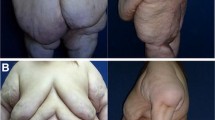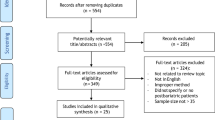Abstract
Introduction
Surgical wound closure is often complicated by suture-related issues. The recent introduction of knotless barbed sutures may address the shortcomings of conventional sutures and offer the additional benefit of reduced operating time. In this paper, we describe our experience with barbed sutures for body-contouring procedures. We share technical insights and evaluate postoperative complications.
Patients and Methods
A retrospective assessment of prospectively collected data over a period of more than 5 years was undertaken. Six hundred twenty-three consecutive patients underwent 695 body-contouring procedures with barbed suture closure. Patients were followed for at least 12 weeks postoperatively. Patient demographics, operation time as well as suture-related complications, such as wound dehiscence and wound site infection were recorded and analyzed.
Results
Barbed sutures can facilitate skin closure, rectus plication, quilting, and deep layer closure in body-contouring procedures. The average operating time in our study cohort was 108 min with reduction mammoplasty being the quickest (94 min) and bodylift (156 min) being the slowest procedure. Sixty-eight patients experienced suture-related complications resulting in an overall complication rate of 9.7 % with thigh lift having the most (15 %) and reduction mammoplasty (7 %) the fewest adverse events.
Conclusion
The use of barbed sutures allows quick closure of lengthy body-contouring incision lines with low complication rates. Our observations support that barbed sutures are safe, convenient and effective. In our hands barbed sutures appear to be superior to traditional wound-closure techniques in body-contouring procedures.
Level of Evidence IV
This journal requires that authors assign a level of evidence to each article. For a full description of these Evidence-Based Medicine ratings, please refer to the Table of Contents or the online Instructions to Authors www.springer.com/00266.







Similar content being viewed by others
References
Murtha AP, Kaplan AL, Paglia MJ, Mills BB, Feldstein ML, Ruff GL (2006) Evaluation of a novel technique for wound closure using a barbed suture. Plast Reconstr Surg 117(6):1769–1780
Kim JC, Lee YK, Lim BS, Rhee SH, Yang HC (2007) Comparison of tensile and knot security properties of surgical sutures. J Mater Sci Mater Med 18(12):2363–2369
Rubin JP, Hunstad JP, Polynice A, Gusenoff JA, Schoeller T, Dunn R et al (2014) A multicenter randomized controlled trial comparing absorbable barbed sutures versus conventional absorbable sutures for dermal closure in open surgical procedures. Aesth Surg J Am Soc Aesth Plast Surg 34(2):272–283
Grigoryants V, Baroni A (2013) Effectiveness of wound closure with V-Loc 90 sutures in lipoabdominoplasty patients. Aesth Surg J Am Soc Aesth Plast Surg 33(1):97–101
Gutowski KA, Warner JP (2013) Incorporating barbed sutures in abdominoplasty. Aesth Surg J Am Soc Aesth Plast Surg 33(3 Suppl):76S–81S
Surgery TASfAP (2013) Cosmetic Surgery National Data Bank [May 23, 2014]
Huemer GM, Schmidt M, Helml GH, Shafighi M, Dunst-Huemer KM (2012) Effective wound closure with a new two-component wound closure device (Prineo) in excisional body-contouring surgery: experience in over 200 procedures. Aesth Plast Surg 36(2):382–386
Huemer GM (2010) Upper body reshaping for the woman with massive weight loss: an algorithmic approach. Aesth Plast Surg 34(5):561–569
Shermak MA (2013) The application of barbed sutures in body contouring surgery. Aesth Surg J Am Soc Aesth Plast Surg 33(3 Suppl):72S–75S
Hammond DC (2013) Barbed sutures in plastic surgery: a personal experience. Aesth Surg J Am Soc Aesth Plast Surg 33(3 Suppl):32S–39S
Pollhammer MS, Duscher D, Schmidt M, Aitzetmuller MM, Tschandl P, Froschauer SM et al (2016) Double-loop dermal suture: a technique for high-tension wound closure. Aesth Surg J Am Soc Aesth Plast Surg 36(4):NP165–NP167
Pollock TA, Pollock H (2012) Progressive tension sutures in abdominoplasty: a review of 597 consecutive cases. Aesth Surg J Am Soc Aesth Plast Surg 32(6):729–742
Pollock H, Pollock T (2000) Progressive tension sutures: a technique to reduce local complications in abdominoplasty. Plast Reconstr Surg 105(7):2583–2586 discussion 7–8
Mohan AT, Rammos CK, Gaba P, Schupbach J, Goede WJ, Ballman K et al (2015) Modified aesthetic abdominoplasty approach in perforator free-flap breast reconstruction: impact of drain free donor site on patient outcomes. J Plast Reconstr Aesth Surg JPRAS 68(6):800–809
Mansberger ARJE, Smith EP, Yeager GH (1951) A new type pull-out wire for tendon surgery: a preliminary report. Bull Univ Md Sch Med 36(3):170–173
Sulamanidze MA, Fournier PF, Paikidze TG, Sulamanidze GM (2002) Removal of facial soft tissue ptosis with special threads. Dermatol Surg Off Publ Am Soc Dermatol Surg [et al]. 28(5):367–371
Wu WT (2004) Barbed sutures in facial rejuvenation. Aesth Surg J Am Soc Aesth Plast Surg 24(6):582–587
Lee S, Isse N (2005) Barbed polypropylene sutures for midface elevation: early results. Arch Facial Plast Surg 7(1):55–61
Paul MD (2013) Barbed sutures in aesthetic plastic surgery: evolution of thought and process. Aesth Surg J Am Soc Aesth Plast Surg 33(3 Suppl):17S–31S
Rosen AD (2013) New and emerging uses of barbed suture technology in plastic surgery. Aesth Surg J Am Soc Aesth Plast Surg 33(3 Suppl):90S–95S
Einarsson JI, Cohen SL, Gobern JM, Sandberg EM, Hill-Lydecker CI, Wang K et al (2013) Barbed versus standard suture: a randomized trial for laparoscopic vaginal cuff closure. J Minim Invasive Gynecol 20(4):492–498
Pham KN, Sack BS, O’Connor RC, Guralnick ML, Langenstroer P, See WA et al (2013) V-Loc urethro-intestinal anastomosis during robotic cystectomy with orthotopic urinary diversion. Can Urol Assoc J = Journal de l’Association des urologues du Canada 7(11–12):E663–E666
Parikh PM, Davison SP, Higgins JP (2009) Barbed suture tenorrhaphy: an ex vivo biomechanical analysis. Plast Reconstr Surg 124(5):1551–1558
Joyce CW, Whately KE, Chan JC, Murphy M, O’Brien FJ, Carroll SM (2014) Flexor tendon repair: a comparative study between a knotless barbed suture repair and a traditional four-strand monofilament suture repair. J Hand Surg (European volume) 39(1):40–45
Eickmann T, Quane E (2010) Total knee arthroplasty closure with barbed sutures. J Knee Surg 23(3):163–167
Joyce CW, Joyce KM, Mahon N, Chan JC, Sugrue CM, Dockery P et al (2014) A novel barbed suture tie-over dressing for skin grafts: a comparison with traditional techniques. J Plast Reconstr Aesth Surg JPRAS 67(9):1237–1241
de Blacam C, Colakoglu S, Momoh AO, Lin SJ, Tobias AM, Lee BT (2012) Early experience with barbed sutures for abdominal closure in deep inferior epigastric perforator flap breast reconstruction. Eplasty 12:e24
Goon P, Man CB, Dickson M (2013) Seroma reduction: using barbed sutures (v-loc) to close latissimus dorsi donor sites. Arch Plast Surg 40(6):787–788
Bartlett LC (1985) Pressure necrosis is the primary cause of wound dehiscence. Can J Surg (Journal canadien de chirurgie) 28(1):27–30
Schmidt M, Pollhammer MS, Januszyk M, Duscher D, Huemer GM (2016) Concomitant liposuction reduces complications of vertical medial thigh lift in massive weight loss patients. Plast Reconstr Surg 137(6):1748–1757
Gingras K, Zaruby J, Maul D (2012) Comparison of V-Loc 180 wound closure device and Quill PDO knotless tissue-closure device for intradermal closure in a porcine in vivo model: evaluation of biomechanical wound strength. J Biomed Mater Res B Appl Biomater 100(4):1053–1058
Duscher D, Maan ZN, Wong VW, Rennert RC, Januszyk M, Rodrigues M et al (2014) Mechanotransduction and fibrosis. J Biomech 47(9):1997–2005
Wong VW, Beasley B, Zepeda J, Dauskardt RH, Yock PG, Longaker MT et al (2013) A mechanomodulatory device to minimize incisional scar formation. Adv Wound Care 2(4):185–194
Gurtner GC, Dauskardt RH, Wong VW, Bhatt KA, Wu K, Vial IN et al (2011) Improving cutaneous scar formation by controlling the mechanical environment: large animal and phase I studies. Ann Surg 254(2):217–225
Lim AF, Weintraub J, Kaplan EN, Januszyk M, Cowley C, McLaughlin P et al (2014) The embrace device significantly decreases scarring following scar revision surgery in a randomized controlled trial. Plast Reconstr Surg 133(2):398–405
Longaker MT, Rohrich RJ, Greenberg L, Furnas H, Wald R, Bansal V et al (2014) A randomized controlled trial of the embrace advanced scar therapy device to reduce incisional scar formation. Plast Reconstr Surg 134(3):536–546
Salzberg CA (2013) Barbed sutures in breast reconstruction. Aesth Surg J Am Soc Aesth Plast Surg 33(3 Suppl):40S–43S
Koide S, Smoll NR, Liew J, Smith K, Rizzitelli A, Findlay MW et al (2015) A randomized ‘N-of-1’ single blinded clinical trial of barbed dermal sutures vs. smooth sutures in elective plastic surgery shows differences in scar appearance 2-years post-operatively. J Plast Reconstr Aesth Surg JPRAS 68(7):1003–1009
Chong T, Coon D, Toy J, Purnell C, Michaels J, Rubin JP (2012) Body contouring in the male weight loss population: assessing gender as a factor in outcomes. Plast Reconstr Surg 130(2):325e–330e
Acknowledgments
Drs. Duscher, Pollhammer, Wenny, Shamiyeh, and Schmidt have no financial interest in any of the products, or devices mentioned in this article. Dr. Huemer serves on the speaker’s bureau of Covidien, which provided suture material. No funding was received for this work.
Author information
Authors and Affiliations
Corresponding author
Additional information
D. Duscher and M. S. Pollhammer contributed equally to this work.
Electronic supplementary material
Below is the link to the electronic supplementary material.
Supplementary material 1 (MP4 150834 kb)
Rights and permissions
About this article
Cite this article
Duscher, D., Pollhammer, M.S., Wenny, R. et al. Barbed Sutures in Body-Contouring: Outcome Analysis of 695 Procedures in 623 Patients and Technical Advances. Aesth Plast Surg 40, 815–821 (2016). https://doi.org/10.1007/s00266-016-0701-2
Received:
Accepted:
Published:
Issue Date:
DOI: https://doi.org/10.1007/s00266-016-0701-2




